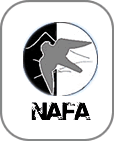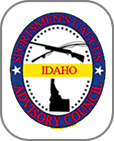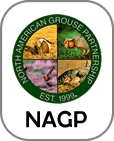Author: Jesse L. Woody
(Reprinted here with the permission of the Author)
"With the old hawk of Sir Ralph's, I have had grand sport. Last year, besides a heavy bag of rabbits, I killed two hares with her. I slipped her at six hares altogether, and she flew at each one with great determination, and caught them all, but four of them, after a splendid 'rough and tumble', to get the best of it, and kicked themselves free before I could get up to her assistance. One was a really magnificent struggle. I let her go at a big hare which jumped up some 40 yards ahead in a large pasture; on her first 'binding' to it, hare and hawk went twice head over heels, and then, the hawk slipping her hold, puss went on alone, leaving heron the ground; but she was not yet defeated, for she picked herself up and again overtook and struck the hare, only to be kicked off again after another struggle. A third time this plucky Goshawk made off after the hare, which managed to reach shelter under some nearby sheep."
-- Captain F.D. Bland thus relates his experience with the Goshawk.
As with all such stories, I should of course, start at the beginning. As a youth of fourteen, I took my first awkward steps into the ancient and completely fascinating practice of falconry, with little else to guide me but my youthful ambition. An American literature book in a junior high school English class provided me with the first glance into my future. It was a well-written story by two young authors who vividly related their first adventures with falconry and birds of prey. It was easy for me to relate to the story. They were near my age and loved the outdoors. I once found an injured hawk that had been hit by a car. It had fallen on its back and spread its wings, with feet wide and showing sharp claws. It was small, but I recognized that it was an adult Sparrow Hawk. I can still feel the thrill and wonder of looking into those deep wild eyes. Fortunately, it was only stunned, for when I tried to cover it with my sweater it flew away. The article by the Craighead brothers describing their experience with birds of prey was absolutely the most fascinating thing I had ever heard of. I looked at the photos and read the text over and over. I wanted to take it home, but the teacher said it would have to remain in the classroom. It didn't matter, I had it memorized and had probably paid more attention to that text on that day than any other since. In my heart, I knew a falconer was born. For the next several months all I could think of was how to learn more about falconry and how to get a hawk. I couldn't find anyone who knew anything about the subject. I was unaware of any falconer in my area. I just started searching encyclopedias and bird books. Finally, I came across some articles in old issues of the National Geographies. There I got my beginning.
Living in a small town in Oklahoma, the only hawks I had available were Kestrels, Broad-Winged and Red-Tailed Hawks. With little or no detailed information, except the National Geographic articles I had "borrowed" from the school library. I blindly rushed ahead with my new passion. To this day, I really don't know how I succeeded overcoming youthful mistakes, impatience, trial and error, and' "grits." In spite of it all, I raised and trained (they came to me) several young Red-Tailed Hawks over the next couple of years. My hunting success was anything by stunning. But still, I called myself a falconer.
Through my high-school years, I climbed nests, raised Red-Tails, trained and hunted with them until I would either lose or release them as winter set in. It wasn't until the summer after I graduated from high-school that I found my first Cooper's Hawk nest. My excitement over finding a "real hawk" was boundless. I climbed the tree and discovered that all but one downey had been eaten by a large black snake that was also in the nest. After almost falling out of the tree, (seeing the snake so dose) I retrieved the remaining downey. Hurrying home with my prize, little did I know that this little tiercel would forever change me life. I believe that's when the real insanity began. These small accipiters became my passion, except for a period in the mid '60's to early 70's when I became interested in the relatively unknown and untried Hams' Hawk of Arizona. After obtaining a tiercel brancher, I avidly flew both sexes of Harris' Hawks for several years. I enjoyed being among those who first flew the Harris' for falconry, but I never lost my desire to fly accipitiers. Goshawks were my next love affair. Over the years I have, like many others, tried my hand at flying a variety of hawks and falcons. No matter which birds I fly, I have always come back to my main passion: Goshawks.
Those of us who take our delight in hawking jackrabbits can well relate to my opening quote taken from "Harting's Hints on the Management of Hawks." Most of my jack-hawking has been with either the female Eastern Red-Tailed Hawk, the female Harris' Hawk or the female North American Goshawk. I have always preferred the flight and performance of the goshawk when hunting jack-rabbits. As Captain Bland so vividly indicated, the hare is usually quite a match for the hawk. That' s what makes it exciting! That's why many of us "grass-hawkers" spend long periods of walking, stumbling, tripping and sometimes falling about the desert in search of our "big game." Before I reached my 50th birthday, I began to notice that there were more holes in the desert and that the sage was getting harder to walk through. To my dismay, more of the jacks were escaping before I could swiftly reach my struggling hawk. More often than not, to the amusement of others, I usually did a couple of nose-dives into the brush or down a badger hole before getting anywhere. Well, I could see the writing on the ole desert floor (up close) and decided if I was going to keep doing what I like doing best --hunting jack-rabbits-- I needed a bigger hawk.
In the early '90's I was fortunate enough to get a call from Dr. Ron Tokar in Walla Walla, WA. He said he had an imprint female Finnish Goshawk that I could work with. He had heard that I had a Finnish tiercel on loan from another breeder and that Marilyn Ernest and I had produced two North American/Finnish hybrids the year before. He asked me if I would work with her. I picked the bird up in Washington during January and by April I had several eggs (it was a little harder than that), but none were fertile. I returned her to Ron that summer. So went the first efforts to produce myself a "Super Hawk." In the fall of '92,1 began flying an exceptional eyas Female American Goshawk. She quickly learned the "ropes" and was an outstanding jack hunter. The only problem was that I found myself running to assist her far too often. At a field meet near Shoshone, I fell hard enough to be unconscious. After once again being offered the chance to fly and work with Ron's big imprint Finnish bird, I stopped running! Now convinced, I had to make myself a big goshawk! Over the next few years with the help of many of my good friends and the use of the European Goshawks loaned to me by Ron Tokar, I successfully produced my first captive European Goshawks in the spring of 1999. They were both tiercels (not a big one yet) and I kept the first one, naming him Jedi, out of the Finnish tiercel The Force." Jedi was a great tiercel, but I had to try again. In the spring of 2000, with the invaluable help of Jim Hansen and Marilyn Emest, I got three more fertile eggs. When the first began to hatch, Marilyn called me and I rushed over with my video camera. I was able to record what was to be my first European female Goshawk. She was followed by two tiercels. As the days passed and she began to grow, it became apparent that this bird was going to have BIG FEET!! I proudly showed off my youngsters at my 60th birthday party and endured the good-natured ribbing about them all being tiercels. Soon, to my relief, I knew the first and oldest was indeed a large female. After over 9 years, it happened. The first year I flew Helga, I was still hung up on the BIG BIRD syndrome. I tried to fly her in the mid to high 40 ounce range and was disappointed. She naturally didn't perform well with others and was very independent in the field. Although everything in her training was geared to prevent aggressions, she was very aggressive. Another year of poor health prevented me from developing her as much as I had wanted. She ended her first season with a fair number of jacks and feather perfect. She was a magnificent-looking goshawk! This year after finishing a complete molt, I am now realizing her full potential as a hare hawk. I am flying her at a lower weight and she has become a "jack-rabbit-harvesting machine." She has rarely lost any rabbit that she has got a foot on and usually has them killed before E can WALK to her. She is truly an impressive hawk and when is comes to jacks
--HELGA REIGNS!


